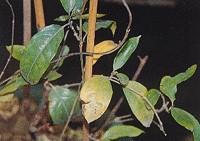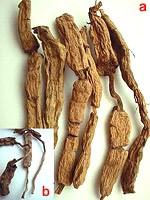Radix Morindae Officinalis
- Name
- Origin
- Where Does It Grow?
- Nature and Flavor
- Identified Active Components / Major Chemical Constituents
- Drug Actions in TCM
- Traditional Uses in TCM
- Pharmacological Actions
- Toxicology
- Administration and Dosage
- Adverse Effect, Side Effects and Cautions
- References
Name
Latin Name: Radix Morindae Officinalis
Common Name: Morinda root
Scientific Name: Morinda officinalis How
Chinese Name: 巴戟天
Pinyin Name: ba ji tian

Origin
The dried root of Morinda officinalis How; family Rubiaceae.1
Where Does It Grow?
Morinda root is mainly distributed in Guangdong, Guangxi and Fujian provinces of China.1,2
Nature and Flavor
Morinda root is sweet and pungent in flavor, slightly warm in nature, and mainly manifests its therapeutic actions in the kidney and liver meridians.1
Identified Active Components / Major Chemical Constituents
Drug Actions in TCM
Morinda root invigorates kidney yang, strengthens bones and tendons, and dispels dampness and wind.1Traditional Uses in TCM
For a declined sexual function, morinda root can be combined with epimedium, processed rhemannia rhizome, Chinese wolfberry and palmleaf raspberry fruit; for infertility, morinda root can be combined with ginseng, Chinese wolfberry, cistanche and Chinese yam; for irregular menses and pain in the lower abdomen, morinda root can be combined with cassia bark, medicinal evodia fruit and galangal.
Morinda root can be combined with cyathula root, mulberry mistletoe, cassia bark, epimedium and snack products to relieve the painful symptoms. For active joint problem, morinda root can work with eucommia bark and seven-lobed yam rhizome to inhibit the inflammatory reactions of the joint.
Modern TCM also uses morinda root to treat problems due to declined estrogen or adrenalin level.
Pharmacological Actions
Animal studies
2. Effects on Stress Response
Animal studies
Animal studies
Toxicology
Administration and Dosage
For decoction, the usual dose of morinda root is 10~15g.
Adverse Effect, Side Effects and Cautions
Individuals who are yin vacuity with internal heat should not take morinda root. The herb is also not recommended for kids.
References
- Lui Daiquan, ed. Chinese Medicine. Shanghai Scientific and Technical Publishers, Jun-2000.
- Li Jiashi, ed. Chinese Medicine Identification. Shanghai Scientific and Technical Publishers, Feb-2000.
- Wu Yiluo. Bancao Congxin (New Compilation of Materia Medica). 1757AD.
- Li Sai, ed. Study of chemical ingredients of in Radix Morindae Officinalis, China Journal of Chinese Materia Medica 1991; 16(11):675.
- Zhou Faqing, et al. Study of chemical ingredients of in Radix Morindae Officinalis, Yixue Tongbao 1986; 21(6):373.
- Chen Yucheng, et al. Study of chemical ingredients of in Radix Morindae Officinalis, Zhongyao Tongbao 1987; 12(10):37.
- Wang Yanfang, et al. Study of chemical ingredients of in Radix Morindae Officinalis, Zhiwu Xuebao 1986; 28(5):566.
- Li Sai, et al. Study of chemical ingredients of in Radix Morindae Officinalis with GC-MS computer integration, Proprietary Chinese Medicine 1990; 12(10):33.
- Li Sai, et al. Ingredients comparison between the cortex and core of Radix Morindae Officinalis, Zhongyao Tongbao 1990; 12(10):33.
- Li Sai, et al. Study on the chemical ingredients in Radix Morindae Officinalis, Study on Proprietary Chinese Medicine 1990; 12(10):33.
- Qiao Zhisheng, et al. Comparison of pharmacological activities of different Radix Morindae Officinalis species, Chinese Journal of Integrated Traditional and Western Medicine 1991; 11(7):415.
- Ma Rou, et al. The effects of paired and single ingredient Chinese Medicine on the hematopoietic cells, Chinese Journal of Integrated Traditional and Western Medicine 1984:4(9):533.
- Shen Daoxiu, et al. Study of Chinese herbal medicine Radix Morindae Officinalis, Chinese Journal of Integrated Traditional and Western Medicine 1985; 5(3):192.
- Quoted in "Wang BX ed. Modern Pharmacological studies on Chinese Medicine. Tianjin Scientific Technology Publishing, 1999: 1255-1256"


